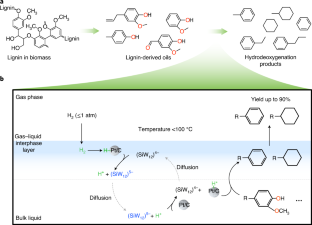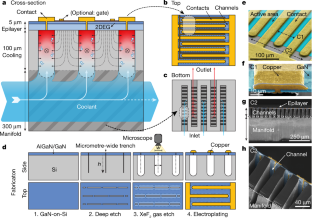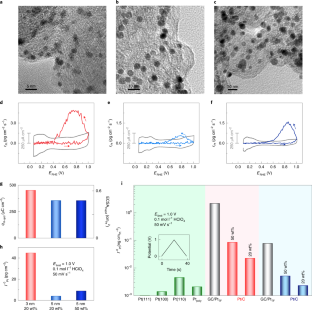(New Process Boosts Lignin Bio-oil as a Next-Generation Fuel)
2020/9/9 アメリカ合衆国・ジョージア工科大学(Georgia Tech)

・ Georgia Tech が、リグニンバイオオイルを炭化水素にアップグレードする低温度の二段階溶液ベースプロセス技術を開発。
・ リグニンは、樹木等や他の木本植物からのセルロースやバイオエタノールの製造で副生する廃棄物。全世界で年間 5 千万トンが排出され、その 95%は燃焼による熱回収に利用されている。
・ 新技術は、分子量の低いリグニン化合物の品質を向上させ、商業利用可能な高品質のバイオ燃料と生化学物質の製造を目指すもの。二元的な触媒システム、超酸と白金ナノ粒子を利用した、リグニンバイオオイルへの水素添加と酸素除去により、より有用な燃料や化学物質原料に転換する。
・ 400℃超の高温度下での熱分解技術でフェノール等のバイオオイルが製造できるが、このようなオイルでは水素が不足すると共に酸素を余分に含むため、燃料としの有用性に欠ける。このため水素化と呼ばれる触媒プロセスによりこの課題に対処しているが、高温度と高圧力を要し、炭化物やタールの生成で白金触媒の効率性が急速に低減する。
・ 今回開発した水素添加と酸素除去の溶液ベースプロセスでは、水素移動促進剤および反応触媒としてポリオキソメタレート(SiW12)を利用することで、低圧力下での水素の低溶解度に起因する、リグニンバイオ燃料の溶液中での水素化や水素化脱酸素反応が困難である課題に対処した。
・ 最初の反応では、SiW2 が可逆的な水素抽出を通じて水素の気液界面からバルク溶液への転換を促進し、炭素担持白金ナノ粒子の表面で活性種 H*として水素を放出。H*は溶液内でリグニンオイルと直接反応する。次に、SiW12 はオイルモノマーから酸素を除去する。
・ 白金粒子と SiW12 は、効率性を維持しながら複数の反応サイクルで再利用できる。100℃を下回る低温度下では、白金触媒での炭化物やタールの形成が無く、触媒活性を維持しながら少なくとも 10 回の利用が可能。リグニンオイル中のモノマーが、水素化と水素化脱酸素反応の効率性を決定することも確認。
・ リグニンバイオ燃料のアップグレード以外の用途として、活性水素や水素ガスの溶解度を大幅に向上させる同技術は、アンモニア合成や他物質の水素化等の化学反応で幅広く利用できる。
・ 今後の課題は、異なる金属触媒システムの利用による選択性の改善と、溶液中のリグニン生化学物質を分離・精製する技術の開発。また、高価で希少な白金を代替する低コスト触媒の開発によるプロセスの実用性の向上を目指す。
URL: http://news.gatech.edu/2020/09/09/new-process-boosts-lignin-bio-oil-next-generationfuel
<NEDO海外技術情報より>
(関連情報)
Nature Energy 掲載論文(アブストラクトのみ:全文は有料)
Ambient-pressure and low-temperature upgrading of lignin bio-oil to hydrocarbons using a hydrogen
buffer catalytic system
URL: https://www.nature.com/articles/s41560-020-00680-x
Abstract
Catalytic hydrodeoxygenation is an essential step for bio-oil upgrading. However, hydrodeoxygenation usually requires a high hydrogen pressure and high temperature due to the good stability of the C–O bonds. Here we report an effective multiphase hydrodeoxygenation of lignin-based bio-oil at temperatures <100 °C and hydrogen pressures <1 atm using a synergetic catalyst system that consists of a low redox potential H4SiW12O40 (SiW12) and suspended Pt-on-carbon (Pt/C) particles. We propose that SiW12 plays three critical roles in bio-oil hydrodeoxygenation. First, it quickly oxidizes the H2 gas to form reduced SiW12 in the presence of Pt/C. Second, it transfers both electrons and H+ ions to the bulk phase to form active H* or H2 on the Pt/C surface. Third, the formation of the oxonium ion in a SiW12 superacid solution reduces the deoxygenation energy. The SiW12-enhanced proton-transfer hydrodeoxygenation mechanism is supported by density functional theory computations. As a result of the hydrogen buffer and acidic effect, up to a 90% yield of hydrocarbons (cyclohexane, benzene and their derivatives) was achieved from the hydrodeoxygenation of phenol and its derivatives.



